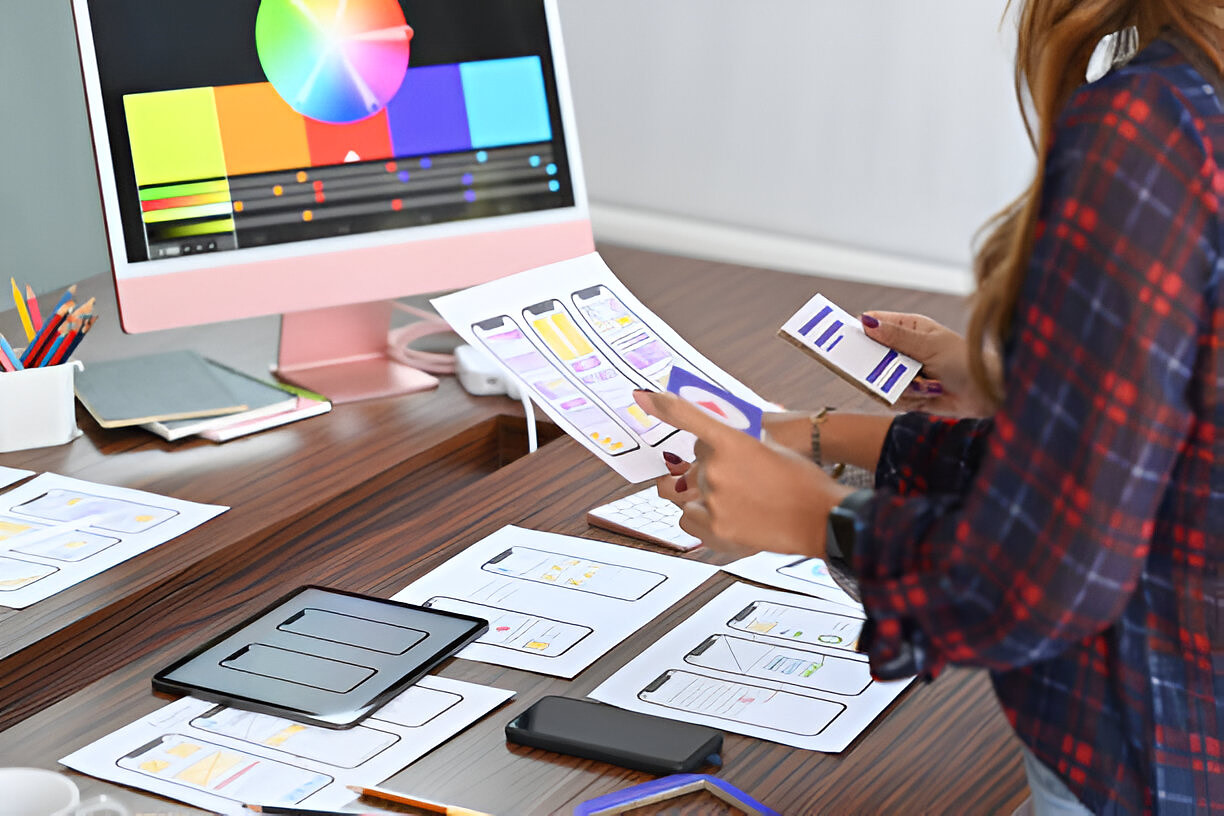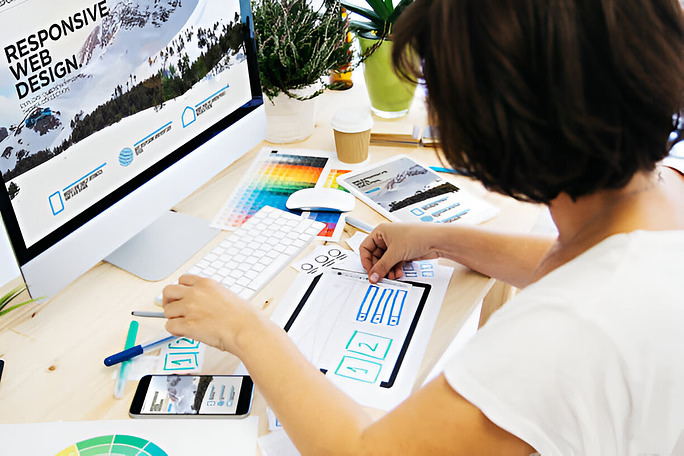AI in graphic design has transformed the creative landscape, introducing a mix of automation and innovation that was previously unimaginable. AI tools are not only enhancing design processes but also pushing the boundaries of what is creatively possible.
Understanding both the potential benefits and drawbacks of integrating AI into your design workflow is crucial. On one hand, AI can significantly improve efficiency by automating repetitive tasks and generating multiple design options swiftly. This allows designers to focus more on the creative aspects of their work. Tools like Adobe Firefly exemplify this capability, streamlining the design process and exploring new ideas.
On the other hand, there are concerns about AI’s potential to displace human designers and produce designs that may lack human-centric qualities. These apprehensions underscore the importance of balancing technological advancements with traditional skills.
The purpose of this article is to delve into how AI tools can improve your graphic design skills. By examining both the advantages and disadvantages, we aim to provide a comprehensive understanding that will help you make informed decisions about incorporating AI into your creative processes.
Understanding AI in Graphic Design
Definition of AI in Graphic Design
Artificial intelligence (AI) in graphic design refers to the integration of machine learning algorithms and intelligent systems into the creative process. These technologies can analyse vast amounts of data, recognize patterns, and automate various design tasks. By leveraging AI, designers can enhance their workflow, generate innovative ideas, and improve the quality of their work.
Examples of Popular AI Tools
Several AI tools are making a significant impact on the graphic design industry:
- Adobe Firefly: This tool uses AI to suggest design elements, color palettes, and layout options based on user preferences. It streamlines the design process by providing real-time recommendations.
- Midjourney: Known for its ability to generate high-quality images from textual descriptions, Midjourney helps designers visualize concepts quickly.
- DALL-E 2: This advanced image generation tool creates unique visuals based on user input. It is particularly useful for generating creative ideas and prototypes.
These tools exemplify how AI can assist designers in exploring new ideas and enhancing their productivity.
The Growing Trend of Integrating AI into Creative Processes

The integration of AI into graphic design is not just a passing trend; it is becoming an essential part of the industry. Designers are increasingly adopting AI tools to:
- Automate Repetitive Tasks: Tasks such as resizing images, adjusting color schemes, and formatting text can be efficiently handled by AI, freeing up time for more creative endeavors.
- Enhance Creativity: By generating multiple design options rapidly, AI allows designers to experiment with different styles and approaches without investing extensive time.
- Improve Accuracy: Intelligent systems can analyze data and provide insights that help in making more informed design decisions.
AI’s role in graphic design continues to expand, offering both opportunities and challenges that designers must navigate. By understanding these tools and trends, professionals can better integrate AI into their workflows and enhance their overall productivity.
The Upsides of Using AI in Graphic Design
1. Increased Efficiency and Productivity with AI Tools
Automating Tasks in Graphic Design
AI tools have transformed the graphic design industry by automating repetitive tasks. These tasks, which once consumed significant time and resources, can now be performed swiftly by intelligent systems. For instance, software like Adobe Firefly can handle background removal, color correction, and resizing—tasks that typically don’t require creative input but are essential to the design process.
Time-Saving Advantages
The automation of mundane tasks allows designers to focus on more creative aspects of their work. This shift not only boosts productivity but also enhances the quality of the output. By leveraging AI, designers can:
- Quickly generate multiple design options: AI algorithms can produce a variety of layouts and styles in a matter of seconds.
- Streamline workflows: Tools like Canva’s Magic Resize feature enable users to adapt designs for different platforms instantly.
These capabilities result in substantial time savings, enabling designers to meet tight deadlines without compromising on creativity.
Case Studies Showcasing Efficiency Improvements
Numerous case studies highlight the tangible benefits of design automation through AI:
- Company X saw a 40% increase in project throughput after integrating AI tools into their workflow.
- Freelancer Y managed to reduce their average project completion time by half, thanks to AI-driven task management features.
Such examples underscore the significant impact of AI on efficiency and productivity within the graphic design sector.
For more insights into optimizing productivity through digital strategies, you might find our article on the crucial role of SEO in digital marketing helpful.
2. Enhanced Creativity and Inspiration from AI Systems
AI systems serve as a rich source of inspiration for designers. By analyzing vast datasets and identifying patterns, these tools can suggest innovative ideas that might not come naturally to human minds. Utilizing AI for creativity offers several advantages:
- Generating diverse design options quickly: With algorithms capable of producing thousands of variations in minutes, designers can explore a wide range of possibilities before settling on the perfect one.
- Collaborative creativity: The synergy between human intuition and machine intelligence often leads to groundbreaking designs that neither could achieve alone.
This collaborative approach ensures that designers remain at the forefront of innovation while using technology as an enabler rather than a replacement.
3. Access to Advanced Features and Tools with Graphics AIs
Modern graphics AIs provide access to advanced features previously unattainable through traditional software:
- Midjourney offers sophisticated generative design capabilities that allow users to create complex visuals effortlessly.
- DALL-E 2, known for its text-to-image generation feature, enables designers to translate written descriptions into detailed images seamlessly.
Comparing these intelligent alternatives with conventional tools reveals clear advantages in terms of flexibility, functionality, and user experience. Designers who adopt these technologies gain a competitive edge by harnessing the power of AI-enhanced features.
Understanding these benefits is crucial for anyone looking to stay ahead in an ever-evolving field. For those interested in exploring effective social media strategies alongside their design efforts, our social media toolkit guide provides valuable information.
4. Enhanced Creativity and Inspiration from AI Systems
AI in graphic design not only automates tasks but also enhances creativity, pushing the boundaries of traditional design processes. This section explores how artificial intelligence can serve as a wellspring of inspiration for designers.
AI as a Source of Inspiration for Designers
AI algorithms analyze vast amounts of data, identifying patterns and trends that might elude human designers. This capability allows AI to generate unique design concepts, often sparking new ideas and creative directions. For instance, tools like Adobe Firefly can suggest unconventional color palettes or layout options based on current design trends and user preferences.
Generating Multiple Design Options Quickly with AI Algorithms
One significant advantage of AI is its ability to produce numerous design variations rapidly. When faced with a design brief, AI tools can create multiple iterations, offering diverse creative solutions within minutes. This rapid generation aids designers in:
- Exploring different styles: Without the time constraints typically associated with manual design.
- Testing various concepts: Assessing multiple ideas before settling on the best one.
- Client presentations: Providing clients with a broader range of options to choose from.
For example, Midjourney and DALL-E 2 are renowned for their ability to produce varied and high-quality visual outputs, streamlining the ideation phase significantly.
Collaboration Between Human Creativity and Machine Capabilities
The synergy between human creativity and machine capabilities leads to innovative outcomes that neither could achieve alone. While AI excels at processing data and generating options, human designers bring intuition, emotion, and cultural context into the mix.
Designers can use AI-generated drafts as starting points, refining them further to align with their vision and emotional resonance. This collaboration ensures that designs retain a human touch while benefiting from the efficiency and novelty introduced by AI systems.
“AI doesn’t replace the designer; it empowers them to push creative boundaries,” says John Doe, a leading graphic designer who integrates AI into his workflow.
By leveraging these intelligent systems, designers can unlock new realms of creativity and inspiration, ultimately leading to more compelling and innovative designs.
5. Access to Advanced Features and Tools with Graphics AIs
AI tools like Midjourney and DALL-E 2 are transforming the world of graphic design by offering advanced features that were once unimaginable. These platforms provide capabilities that go beyond traditional design software, making them essential for today’s designers.
Midjourney: Unleashing Imagination in Design
Midjourney is known for its ability to generate highly detailed and imaginative visual content. It uses machine learning algorithms to create unique designs based on user inputs. With Midjourney, designers can:
- Generate Concept Art: Quickly produce high-quality concept art, saving hours of manual illustration work.
- Style Transfer: Apply artistic styles from famous artworks to their projects, adding a unique touch to the final design.
- Image Enhancement: Improve image quality by upscaling resolutions and refining details with minimal effort.
DALL-E 2: Turning Words into Visuals
DALL-E 2, developed by OpenAI, takes things even further with its ability to create images from textual descriptions. This tool exemplifies how AI enhances creativity in design by turning simple text prompts into vivid imagery. Key features include:
- Text-to-Image Generation: Convert any descriptive text into a corresponding image, opening up endless creative possibilities.
- Inpainting: Edit parts of an image intelligently while preserving the overall context, allowing for seamless modifications.
- Creative Variations: Generate multiple variations of a single concept, aiding in rapid prototyping and brainstorming.
The Difference Between Traditional Software and AI-Powered Tools
When comparing these AI-driven tools to traditional software, several distinctions stand out:
| Traditional Software | AI-Powered Tools | Limited automation capabilities | Extensive task automation | | Requires significant manual input | Generates designs from simple prompts | | Standard feature sets | Advanced features like style transfer and inpainting |
Traditional graphic design software often requires extensive manual effort for tasks such as color correction, object removal, or generating multiple design variations. In contrast, AI-powered tools streamline these processes through design automation benefits, enabling designers to focus more on the creative aspects.
By automating tasks in graphic design and offering sophisticated features like text-to-image generation and style transfer, AI tools not only enhance productivity but also expand the creative horizons for designers. These advancements are reshaping the industry, making it essential for professionals to integrate such technologies into their workflows.
Exploring these modern alternatives reveals a significant leap towards efficiency and creativity that traditional methods simply cannot match.
The Downsides to Consider When Using Graphics AIs
1. Potential Job Displacement Due to Automation Technologies
AI tools have changed the graphic design industry by making workflows smoother and taking care of repetitive tasks. But this technological progress comes with its own set of problems, especially when it comes to the possibility of human designers losing their jobs.
Concerns about automation replacing human designers’ roles
Many professionals in the field worry that AI’s ability to perform tasks traditionally done by humans could lead to significant job losses. Graphic design involves a variety of tasks, from simple adjustments to complex creative processes. AI systems can now handle many of these tasks efficiently:
- Simple Adjustments: Tools like Adobe Firefly can automate color correction and basic photo editing.
- Complex Creative Processes: Advanced AI systems like Midjourney and DALL-E 2 are capable of generating high-quality images and creative concepts based on textual descriptions.
These capabilities suggest that businesses might opt for AI solutions over hiring additional human designers, especially for cost-saving benefits. The risk here is substantial: as AI continues to evolve, it might encroach upon more areas traditionally within the human domain.
Analysis of potential market shrinking effects caused by widespread adoption
The widespread adoption of AI in graphic design could potentially shrink the market for human designers. Several factors contribute to this concern:
- Cost Efficiency: Companies may prefer investing in AI tools that offer a one-time expense or subscription fee rather than ongoing salaries for multiple designers.
- Speed and Scalability: AI can produce work at a much faster rate than humans, allowing businesses to scale their creative output without proportional increases in staff.
This shift could lead to reduced opportunities for new designers entering the market and pressure on existing professionals to adapt quickly or face obsolescence.
Balancing Innovation and Human Creativity
While AI offers impressive efficiency and innovative capabilities, it’s crucial to recognize that it lacks certain human-centric qualities essential in design:
“AI can replicate style and patterns but often fails to capture the emotional depth and unique touch that human designers bring.”
Maintaining a balance between leveraging AI tools and preserving human creativity is essential. Designers should focus on skills that machines cannot easily replicate, such as deep emotional intelligence, cultural awareness, and innovative thinking.
2. Lack of Human-Centric Qualities in Machine-Generated Designs
One major concern with using AI tools for design is the empathy gap with AI-created artworks. Unlike traditional artwork, which often conveys deep emotions and captures the intricacies of human experience, purely algorithmic outputs may struggle to replicate these qualities.
Emotional Aspects in Traditional Artwork
Human designers bring their personal experiences, cultural backgrounds, and emotional depths into their creations. This inherent quality resonates with audiences on a profound level. For example:
- Personal Touch: Hand-drawn illustrations or paintings can convey an artist’s unique perspective, making each piece distinct.
- Cultural Relevance: Artworks often reflect societal values, historical events, and collective memories—elements that AI might not fully understand.
Quality Concerns of Automated Creations
While AI tools like Adobe Firefly offer impressive capabilities, there are notable quality concerns regarding purely automated creations. These concerns include:
- Lack of Depth: AI-generated designs might lack the layered meanings and subtle details that come naturally to human artists.
- Predictability: Algorithms often rely on patterns and data sets, potentially leading to repetitive or uninspired designs.
“An AI might generate visually appealing graphics, but without a human touch, it risks losing the emotive power that makes art truly impactful.”
Balancing Automation with Human Insight
To mitigate these risks, it’s crucial to strike a balance between leveraging AI for efficiency and maintaining human insight for creativity. Designers should aim to:
- Use AI as a tool for inspiration, not a replacement for original thought.
- Ensure that final designs undergo human review and refinement to retain emotional depth.
By acknowledging these limitations and actively working to address them, designers can harness the benefits of AI while preserving the essence of human-centric design.
3. Dependence on Technology: Balancing Innovation and Tradition as a Designer
The growing integration of AI tools in the graphic design industry has led to concerns about over-reliance on technology. While these tools offer significant advancements, they also bring potential risks associated with their extensive use.
Risks Associated with Over-Dependence on Smart Systems for Creative Work
Over-relying on AI for creative tasks can stifle originality and innovation. Designers might become heavily dependent on algorithms to generate ideas, which could result in a homogenized output lacking unique human touch. This dependency poses a risk to creativity, as designers might gradually lose the ability to think outside the box and rely more on predefined patterns generated by AI.
Importance of Maintaining Traditional Skills Alongside New Technology
Balancing AI innovation with traditional skills is critical. Despite the efficiency AI offers, maintaining foundational design skills ensures that designers can create work that resonates emotionally and culturally with audiences. Traditional techniques provide a deeper understanding of aesthetics and craftsmanship that machines cannot fully replicate.
To mitigate these risks:
- Continuous Learning: Regularly update your knowledge of both traditional design principles and new AI advancements.
- Hybrid Approach: Integrate AI tools selectively into your workflow while retaining manual processes where creativity is paramount.
- Skill Diversification: Cultivate skills in areas such as drawing, typography, and color theory alongside technical proficiency in AI systems.
By striking a balance between leveraging technological advancements and preserving core design principles, designers can harness the best of both worlds. This approach not only enhances productivity but also ensures the retention of distinctive human qualities in their work.
“Maintaining one’s roots while embracing new technologies is key to sustaining true creativity.”
Skills Designers Should Develop for an AI-Driven Landscape
1. Programming Knowledge: Bridging the Gap Between Humans & Machines
Understanding how to code is becoming an essential ability for future-proofing your career in graphic design. The intersection of programming and design offers a unique advantage, enabling designers to leverage AI tools more effectively.
How can understanding programming languages enhance collaboration with intelligent systems?
- Enhanced Customization: Knowing languages like Python allows designers to tailor AI tools to specific needs. For example, customizing algorithms to better align with a project’s creative vision.
- Improved Efficiency: Basic coding skills help streamline workflows by automating tedious tasks. Python scripts can handle repetitive actions, freeing up more time for imaginative endeavors.
- Better Communication: With a foundation in coding, designers can communicate more effectively with developers, leading to seamless integration of AI technologies within design projects.
- Data Manipulation: Proficiency in programming enables the manipulation and analysis of data, which is crucial for making informed design decisions based on analytics.
Coding Basics Every Designer Should Know
- Python: One of the most accessible programming languages, known for its readability and versatility. Python is extensively used in AI development and data analysis.
- JavaScript: Essential for web-based projects, JavaScript allows designers to create interactive elements and manipulate graphics on online platforms.
- HTML/CSS: Fundamental for any designer working with web content, providing the backbone for structuring and styling websites.
Example: A designer might use Python’s libraries like TensorFlow or Keras to build simple machine learning models that generate color schemes or layout suggestions based on user input.
To thrive in an AI-driven landscape, incorporating programming knowledge into your skillset bridges the gap between human creativity and machine capabilities. This integration not only enhances your ability to work alongside intelligent systems but also ensures you remain competitive in a rapidly evolving industry.
2. Data Literacy: Making Informed Decisions Through Analytics
In today’s data-driven world, possessing data literacy is one of the essential abilities for future-proofing your career in graphic design. The ability to analyze and interpret data can significantly enhance your design process, allowing you to make informed decisions that are backed by solid evidence.
How Data-Driven Insights Influence Design Choices
Data-driven insights play a crucial role in making successful design choices. Here’s how:
- Client Preferences: By analyzing customer feedback and usage data, designers can tailor their work to meet client needs more effectively.
- Market Trends: Staying updated with market trends through data analytics helps in creating relevant and timely designs.
- User Behavior: Understanding how users interact with designs provides valuable insights for improving user experience.
Tools for Gaining Data Insights
Several tools and platforms can assist designers in gaining these insights:
- Google Analytics: Provides comprehensive data on website performance and user interactions.
- Adobe Analytics: Offers detailed metrics specifically tailored for creative professionals.
Incorporating these insights into your workflow ensures that your designs are not just visually appealing but also strategically sound. This ability to marry aesthetics with analytics sets a designer apart in an increasingly competitive landscape.
Data literacy is as crucial as mastering coding basics every designer should know, such as Python or Java, which were discussed previously. While programming skills facilitate better collaboration with AI systems, data analysis ensures that the creative decisions made are both innovative and efficient.
Understanding how to leverage data can lead to more targeted and effective designs, enhancing both client satisfaction and project success rates. Combining these analytical skills with creativity results in a holistic approach to modern graphic design.
3. Creative Thinking & Innovation: Staying Ahead Despite Automation’s Rise
Essential abilities for future-proofing your career lie in developing creative thinking and fostering innovation, even as AI continues to advance within the graphic design industry. While smart tools can handle repetitive tasks and offer efficiency, maintaining a unique perspective remains crucial.
Strategies for Maintaining Originality
- Embrace Diverse Inspirations: Exploring various art forms, cultures, and historical periods can help keep your designs fresh and original.
- Continuous Learning: Engaging in ongoing education through courses, workshops, and seminars ensures you stay updated with both traditional techniques and modern trends.
- Experimentation: Regularly test new tools and technologies without the fear of failure. This practice can lead to unexpected breakthroughs and innovative ideas.
Balancing Human Creativity with AI Capabilities
AI’s ability to generate multiple design options quickly should not overshadow the human touch. Instead, consider AI as an assistant rather than a replacement:
“AI can suggest numerous possibilities, but it is the designer’s intuition that selects the most fitting solution.”
Coding Basics Every Designer Should Know
Understanding basic programming concepts can enhance collaboration with intelligent systems. Familiarity with languages like Python or JavaScript allows designers to customize tools and optimize workflows:
- Automation Scripts: Use simple scripts to automate repetitive tasks beyond what off-the-shelf software offers.
- Custom Filters/Effects: Develop unique visual effects that are not available in standard software packages.
Incorporating these skills ensures a well-rounded approach that leverages both human creativity and machine efficiency. This blend of artistic intuition and technical acumen represents a formidable strategy for staying competitive amidst automation’s rise in the graphic design landscape.
Best Practices for Integrating Graphics AIs Seamlessly Into Your Workflow
To effectively collaborate with AI in graphic design, consider these best practices:
- Start Small: Begin by integrating AI tools for specific tasks like image enhancement or layout suggestions.
- Stay Updated: Regularly update your software and stay informed about the latest AI advancements.
- Balance Automation with Creativity: Use AI to handle repetitive tasks, freeing up time for more creative endeavors.
- Customized Training: Tailor AI systems to align with your unique design style and preferences.
Feedback Loop: Continuously provide feedback to improve AI performance and ensure it meets your standards.
FAQs (Frequently Asked Questions)
AI in graphic design enhances creative processes by automating repetitive tasks, providing inspiration, and offering advanced features that improve efficiency and productivity. Understanding both the benefits and drawbacks of AI tools is crucial for designers.
Popular AI tools for graphic design include Adobe Firefly, Midjourney, and DALL-E 2. These tools offer various features that aid designers in creating innovative designs more efficiently.
AI enhances creativity by generating multiple design options quickly, providing creative assistance, and facilitating collaboration between human designers and machine capabilities. This allows designers to explore new ideas and inspiration more effectively.
The downsides include potential job displacement due to automation, a lack of human-centric qualities in machine-generated designs, and an over-reliance on technology which may diminish traditional skills among designers.
Designers should focus on developing programming knowledge (like Python), data literacy to make informed decisions through analytics, and creative thinking to maintain originality despite the rise of automation.
Designers can integrate graphics AIs by collaborating effectively with machines, understanding how to leverage AI tools for automating tasks while maintaining a balance between innovation and traditional design skills.



